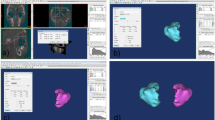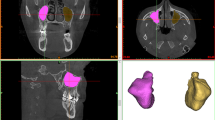Abstract
Purpose
Ectodermal dysplasia (ED) is a congenital syndrome characterized by abnormal development of ectodermal structures, such as skin, hair, nails, teeth, or salivary glands. Patients with ED demonstrate craniofacial dysmorphology, midfacial hypoplasia and hypodontia. The aim of this study is to evaluate volume and surface area of maxillary sinus and craniofacial structures in patients with ectodermal dysplasia (ED) using cone-beam computed tomography (CBCT) images.
Methods
The CBCT images of 20 patients with ED (study group) and 20 healthy individuals (control) which are equal in terms of age and gender were evaluated. After a three-dimensional analysis and segmentation of each maxillary sinus, the volume and surface area were calculated. Craniofacial dimensions were measured on the sagittal planes of the CBCT images. The results of the ED and control groups were statistically compared.
Results
The right and left sinus volumes and surface areas were significantly lower in the ED group than in the control group (p < 0.05) while the SNA was significantly higher (p < 0.05). ANB and SN-GoMe were also lower in patients with ED than in controls (p < 0.05). The difference in SNB values between the two groups was not significant (p > 0.05).
Conclusions
The volumes and surface areas of both maxillary sinuses were found to be smaller in patients with ED compared to healthy individuals. Class III malocclusion with maxillary retrusion is a characteristic craniofacial feature of these patients.


Similar content being viewed by others
References
Kere J, Srivastava AK, Montonen O et al (1996) X-linked anhidrotic (hypohidrotic) ectodermal dysplasia is caused by mutation in a novel transmembrane protein. Nat Genet 13:409–416
Yenisey M, Guler A, Unal U (2004) Orthodontic and prosthodontic treatment of ectodermal dysplasia—a case report. Br Dent J 196:677–679
Levin LS (1988) Dental and oral abnormalities in selected ectodermal dysplasia syndromes. Birth Defects Orig Artic Ser 24:205–227
Clarke A, Phillips DI, Brown R, Harper PS (1987) Clinical aspects of X-linked hypohidrotic ectodermal dysplasia. Arch Dis Child 62:989–996
de Aquino SN, Paranaíba LMR, Swerts MSO et al (2012) Orofacial features of hypohidrotic ectodermal dysplasia. Head Neck Pathol 6:460–466
Ruhin B, Martinot V, Lafforgue P et al (2001) Pure ectodermal dysplasia: retrospective study of 16 cases and literature review. Cleft Palate Craniofac J 38:504–518
Worsaae N, Jensen BN, Holm B, Holsko J (2007) Treatment of severe hypodontia-oligodontia-an interdisciplinary concept. Int J Oral Maxillofac Surg 36:473–480
Mills R, Montague M-L, Naysmith L (2004) Ear, nose and throat manifestations of ectodermal dysplasia. J Laryngol Otol 118:406–408
Gündüz Arslan S, Devecioǧlu Kama J, Özer T, Yavuz I (2007) Craniofacial and upper airway cephalometrics in hypohidrotic ectodermal dysplasia. Dentomaxillofac Radiol 36:478–483
de Rezende Barbosa GL, Pimenta LA, Pretti H et al (2014) Difference in maxillary sinus volumes of patients with cleft lip and palate. Int J Pediatr Otorhinolaryngol 78:2234–2236
Emirzeoglu M, Sahin B, Bilgic S et al (2007) Volumetric evaluation of the paranasal sinuses in normal subjects using computer tomography images: a stereological study. Auris Nasus Larynx 34:191–195
Endo T, Abe R, Kuroki H et al (2010) Cephalometric evaluation of maxillary sinus sizes in different malocclusion classes. Odontology 98:65–72
Kuijpers MAR, Pazera A, Admiraal RJ et al (2014) Incidental findings on cone beam computed tomography scans in cleft lip and palate patients. Clin Oral Investig 18:1237–1244
Carter L, Farman AG, Geist J et al (2008) American Academy of Oral and Maxillofacial Radiology executive opinion statement on performing and interpreting diagnostic cone beam computed tomography. Oral Surg Oral Med Oral Pathol Oral Radiol Endodontol 106:561–562
Nakayama Y, Baba Y, Tsuji M et al (2015) Dentomaxillofacial characteristics of ectodermal dysplasia. Congenit Anom (Kyoto) 55:42–48
Myer CM (1986) Otolaryngologic manifestations of the ectodermal dysplasias—clinical note. Int J Pediatr Otorhinolaryngol 11:307–310
Callea M, Teggi R, Yavuz I et al (2013) Ear nose throat manifestations in hypohidrotic ectodermal dysplasia. Int J Pediatr Otorhinolaryngol 77:1801–1804
Mehta U, Brunworth J, Lewis RA, Sindwani R (2007) Rhinologic manifestations of ectodermal dysplasia. Am J Rhinol 21:55–58
Salib S, Chaudri RJ, Rockley S TJ (2001) Sinusitis in the hypoplastic maxillary antrum: the crucial role of radiology in diagnosis and management. J Laryngol Otol 115:676–678
Tikku T, Khanna R, Sachan K et al (2013) Dimensional changes in maxillary sinus of mouth breathers. J Oral Biol Craniofac Res 3:9–14
Agacayak KS, Gulsun B, Koparal M et al (2015) Alterations in maxillary sinus volume among oral and nasal breathers. Med Sci Monit 21:18–26
Yavuz I, Baskan Z, Ulku R et al (2006) Ectodermal dysplasia: Retrospective study of fifteen cases. Arch Med Res 37:403–409
Bryant PA, Croft J, Cole P (2018) Integration of risks from multiple hazards into a holistic ALARA/ALARP demonstration. J Radiol Prot 38:81–91
Möhlhenrich SC, Heussen N, Peters F et al (2015) Is the maxillary sinus really suitable in gender determination? A three-dimensional analysis of maxillary sinus volume and surface depending on gender and dentition. J Craniofac Surg 26:723–726
Uthman AT, Al-Rawi NH, Al-Naaimi AS, Al-Timimi JF (2011) Evaluation of maxillary sinus dimensions in gender determination using helical CT scanning. J Forensic Sci 56:403–408
Cohen O, Warman M, Fried M, Shoffel-Havakuk H, Adi M, Halperin DLY (2017) Volumetric analysis of the maxillary, sphenoid and frontal sinuses: a comparative computerized tomography based study. Auris Nasus Larynx 45:96–102
Sahlstrand-Johnson P, Jannert M, Strömbeck A, Abul-Kasim K (2011) Computed tomography measurements of different dimensions of maxillary and frontal sinuses. BMC Med Imaging 11:1–7
Kawarai Y, Fukushima K, Ogawa T et al (1999) Volume quantification of healthy paranasal cavity by three-dimensional CT imaging. Acta Otolaryngol 119:45–49
Fernandes CL (2004) Volumetric analysis of maxillary sinuses of Zulu and European crania by helical, multislice computed tomography. J Laryngol Otol 118:877–881
Oktay H (1992) The study of the maxillary sinus areas in different orthodontic malocclusions. Am J Orthod Dentofac Orthop 102:143–145
Erdur O, Ucar FI, Sekerci AE et al (2015) Maxillary sinus volumes of patients with unilateral cleft lip and palate. Int J Pediatr Otorhinolaryngol 79:1741–1744
Kulczyk T, Przystańska A, Rewekant A et al (2017) Maxillary sinuses and midface in patients with cleidocranial dysostosis. Ann Anat Anat Anzeiger 215:78–82
Funding
No funding resource is associated with this study.
Author information
Authors and Affiliations
Corresponding author
Ethics declarations
Conflict of interest
The authors declare that they have no conflict of interest.
Ethical approval
All procedures performed in studies involving human participants were in accordance with the ethical standards of the institutional and/or national research committee and with the 1964 Helsinki declaration and its later amendments or comparable ethical standards. The protocol of the study was approved by the Ethical Committee of Sanko University: number 2018/04–08.
Informed consent
Informed consent was obtained from all patients for being included in the study.
Rights and permissions
About this article
Cite this article
Yalcin, E.D., Koparal, M. & Aksoy, O. The effect of ectodermal dysplasia on volume and surface area of maxillary sinus. Eur Arch Otorhinolaryngol 275, 2991–2996 (2018). https://doi.org/10.1007/s00405-018-5177-z
Received:
Accepted:
Published:
Issue Date:
DOI: https://doi.org/10.1007/s00405-018-5177-z




